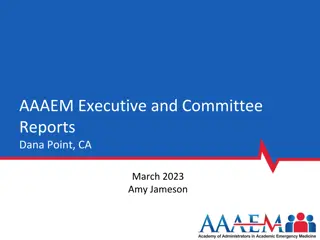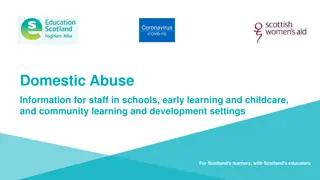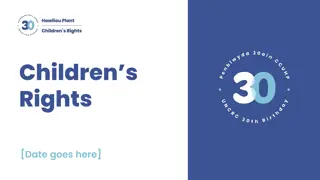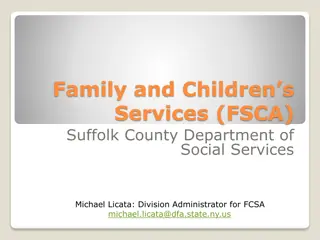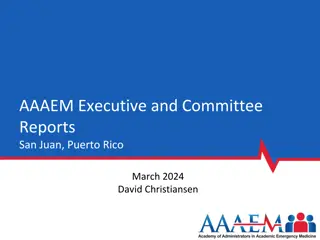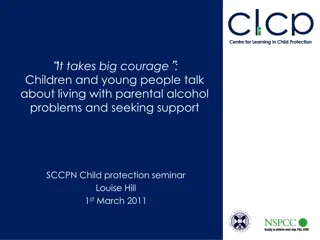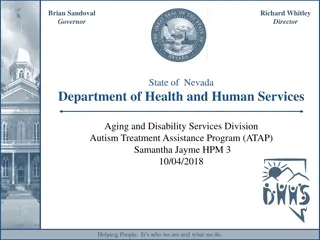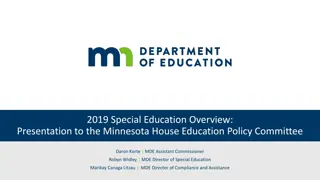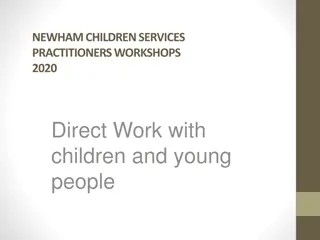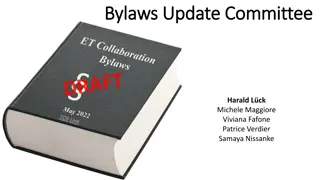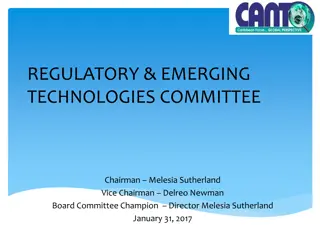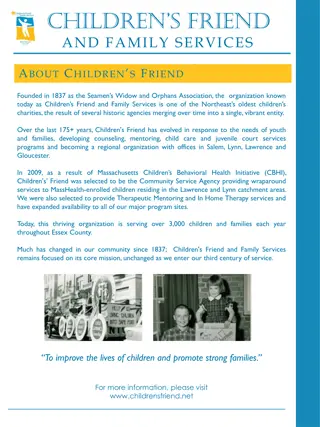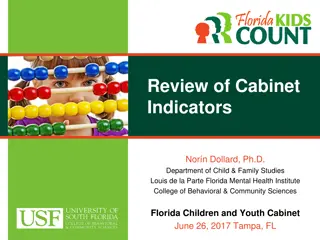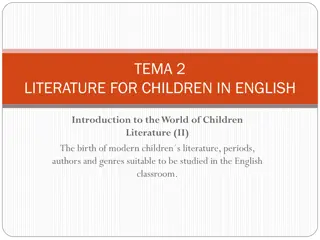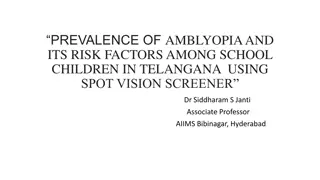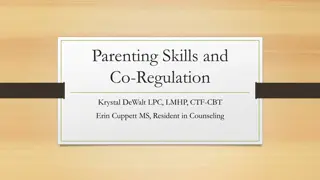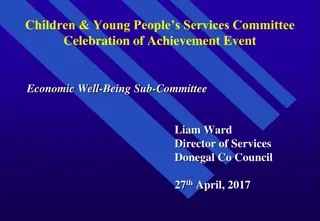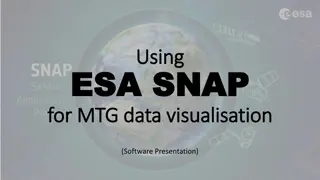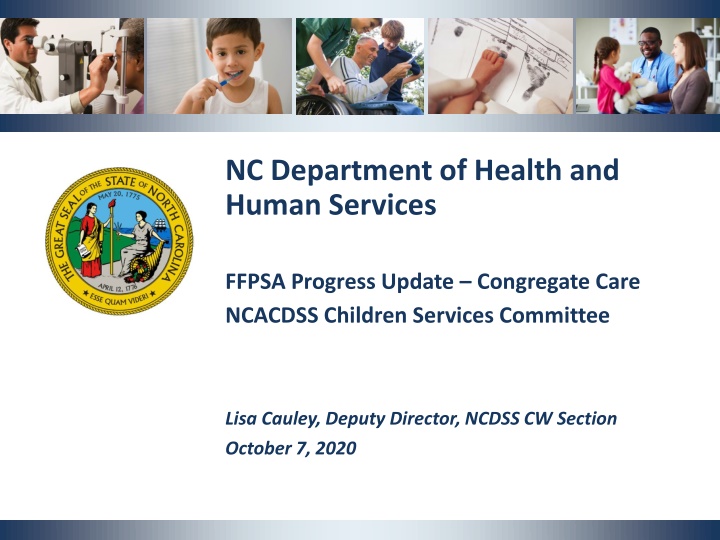
FFPSA Progress Update: Congregate Care Funding Limitations Explained
Learn about key provisions of the Family First Prevention Services Act (FFPSA) regarding congregate care, including limitations on funding after 14 days. Qualified Residential Treatment Programs are also discussed, outlining the trauma-informed treatment model and requirements for family involvement and aftercare support.
Download Presentation

Please find below an Image/Link to download the presentation.
The content on the website is provided AS IS for your information and personal use only. It may not be sold, licensed, or shared on other websites without obtaining consent from the author. If you encounter any issues during the download, it is possible that the publisher has removed the file from their server.
You are allowed to download the files provided on this website for personal or commercial use, subject to the condition that they are used lawfully. All files are the property of their respective owners.
The content on the website is provided AS IS for your information and personal use only. It may not be sold, licensed, or shared on other websites without obtaining consent from the author.
E N D
Presentation Transcript
NC Department of Health and Human Services FFPSA Progress Update Congregate Care NCACDSS Children Services Committee Lisa Cauley, Deputy Director, NCDSS CW Section October 7, 2020 1
Key Family First Provisions Allows IV-E reimbursement for services to prevent entry into foster care Limits IV-E funding for congregate care to the first two weeks of placement* States may opt into prevention plan as early as October 2019 however, changes to congregate care go into effect Oct 1, 2021 for all states Other provisions to support safety, permanence and well-being * With some exceptions 2
FFPSA: Congregate Care Funding Limitations Beginning after Beginning after 14 days of entry* 14 days of entry* into foster care, federal IV IV- -E reimbursement for foster care payments are limited to E reimbursement for foster care payments are limited to children in: children in: A licensed foster family home A licensed foster family home A Qualified Residential Treatment Program (QRTP) A Qualified Residential Treatment Program (QRTP) An approved setting specializing in providing prenatal, post An approved setting specializing in providing prenatal, post- - partum or parenting supports for youth partum or parenting supports for youth An approved supervised setting for youth ages 18+ who are living An approved supervised setting for youth ages 18+ who are living independently independently An approved setting providing high An approved setting providing high- -quality residential care and supportive services to children who have been or at risk of being supportive services to children who have been or at risk of being sex trafficking victims sex trafficking victims into foster care, federal quality residential care and *This is the 2 *This is the 2- -week rule. week rule. 3 3
4 4 Qualified Residential Treatment Programs Qualified Residential Treatment Programs Trauma-informed treatment model Model is designed to meet the specific clinical needs of children as identified in the child s assessment Has registered or licensed nursing staff and other licensed clinical staff (on-site consistent with the treatment model, and available 24/7) Facilitates family participation in child s treatment program, facilitates family outreach, and documents how the child s family is integrated into child s treatment (including post-discharge) Provides discharge planning and family-based aftercare supports for 6+ months post discharge Licensed and accredited by CARF, JCAHO, COA or other bodies approved by HHS Secretary 4
Who does this apply to? Approximately 950 children in Congregate Care who are IV-E eligible: 750 in residential child-care facilities MonthlyCost approx. $4000 per child 200 in residential treatment facilities Monthly Cost approx. $600 per child, due to Medicaid funding 5
Importance of 10/1/2021 Those placed in congregate care prior to this date: Remain eligible for IV-E reimbursement as long as their placement does not change. IV-E reimbursement subject to the 2-week rule only if they move on or after 10/1/2021. Placements on or after 10/1/2021 are subject to the 2-week rule. Family First Prevention Services Act | August 2018 6
Loss of Revenue for Congregate Care Initial and increasing loss beginning Oct 1, 2021, for children newly placed in congregate care placements that do not meet QRTP requirements Year 1: Estimate loss at 3 million* *This figure is a projected estimate and is subject to change 7
What has to happen to make this transition? Increase placements in family settings: Recruit for foster families for teens and sibling groups Placements with relatives Stand up Qualified Residential Treatment Facilities Provide funding to bridge gap through FFPSA Transition Act Funds and consider if a legislative ask is needed. 8
Next Steps: Analyze project revenue loss for congregate care: Nov 1, 2020 Complete Needs Assessment for children in congregate care: Administrative data review (complete) Survey needed regarding specific needs of children Information provided will be used to build new model of care. 9
Questions? 10
NC Department of Health and Human Services LINKS Funding NCACDSS Children Services Committee Erin Conner, LINKS Program Coordinator, Permanency Planning Section October 7, 2020 11
LINKS COVID Funds Eligibility Use of Funds Transitional Living Services: Available to support eligible young adults with transitional costs due to COVID-19. Examples include: Transportation Food Supplementing losses in income All young adults who aged out of foster care who: Are between ages 18 and 21 years old; Are not in Foster Care 18 to 21: and, Need assistance with housing or transitional services due to COVID-19 Transitional Housing: This includes rent, rent deposits, room and board, down payments on dwellings 12
LINKS COVID Funds: Accessing Funds 1. Determine eligibility for young adult 2. Identify a need and advance funds for the expenditure 3. Request reimbursement of LINKS COVID funds 4. Submit reimbursement request form via email to linksreimbursement@dhhs.nc.gov 13
LINKS COVID Funds: Status of Funds Transitional Housing Budgeted: $40,000 Budgeted: $250,000 YTD Expenditures: $8,850 YTD Expenditures: $5,062 Balance: $31,150 Balance: $244,938 Funds must be expensed by December Funds must be expensed by December 14
LINKS Special Funds Eligibility Use of Funds Transitional: These funds are available to support LINKS- eligible youth and young adults with accomplishing one or more of the LINKS outcomes. Youth who are 13 or older and are not yet 21 and who are or were in foster care after the age of 13 are eligible, with two exceptions: Housing: These funds are for young adults who have aged out of foster care at 18 and are not yet 21 years old to assist with rent, rent deposits, and room and board arrangements. Youth who have personal reserves of more than $10,00 Youth who are undocumented immigrants 15
LINKS Special Funds: Status Transitional Housing Budgeted: $140,000 Budgeted: $756,334 YTD Expenditures: $52,154 YTD Expenditures: $160,330 Balance: $87,846 Balance: $596,024 16
Questions? 17
NC Department of Health and Human Services 2021 Federal Review of North Carolina IV-E Permanency Planning Cases NCACDSS Children Services Committee Evan Friedel, Title IV-E Coordinator, Licensing & Regulatory Section October 7, 2020 18
Basics about the IV-E Review What is a IV What is a IV- -E review and why do we have it? E review and why do we have it? Audit is based on Maintenance (Board) Payments Audit is based on Maintenance (Board) Payments 80 cases will be reviewed (100 pulled, 20 oversample) 80 cases will be reviewed (100 pulled, 20 oversample) Allowed to have 4 errors and still pass Allowed to have 4 errors and still pass More than 4 errors lead to a second review of 160 More than 4 errors lead to a second review of 160 cases. cases. Not passing that 2 Not passing that 2nd review will lead to a statewide penalty for all counties. penalty for all counties. nd review will lead to a statewide 19 19
Preparation Use the Federal IV Use the Federal IV- -E tool to review every open E tool to review every open Permanency Case that gets IV Permanency Case that gets IV- -E reimbursement Review all open 5094s to ensure that closed Review all open 5094s to ensure that closed cases are actually closed cases are actually closed Review PQA 020 every month to ensure Review PQA 020 every month to ensure payments are reconciled correctly payments are reconciled correctly E reimbursement 20 20
Changes in Enforcement Expectations In previous reviews North Carolina provided payment In previous reviews North Carolina provided payment histories for every child in the sample histories for every child in the sample This history included every paid placement the child This history included every paid placement the child resided in during the Period Under Review (PUR) and resided in during the Period Under Review (PUR) and was based on what the county was based on what the county stated provider as per entry on the 5094 provider as per entry on the 5094 For example if a county listed they paid $634 for a For example if a county listed they paid $634 for a child for the month ,and that child was IV child for the month ,and that child was IV- -E eligible, that $634 was submitted as a reimbursable expense that $634 was submitted as a reimbursable expense No further verification was required in order for the No further verification was required in order for the county to receive reimbursement and the audit county to receive reimbursement and the audit examined our process based on the claimed examined our process based on the claimed payments payments stated they paid each they paid each E eligible, 21 21
Changes in Enforcement Expectations Continued During preparatory discussion with ACF they have During preparatory discussion with ACF they have indicated this information alone will no longer be indicated this information alone will no longer be acceptable and they will be enforcing a higher standard acceptable and they will be enforcing a higher standard of accountability in the 2021 review of accountability in the 2021 review Specifically North Carolina will be required to provide Specifically North Carolina will be required to provide actual evidence of bills/invoices from placement actual evidence of bills/invoices from placement providers and documentation of payment by the county providers and documentation of payment by the county to these providers to these providers That amount paid will need to match the amount That amount paid will need to match the amount requested by the county for reimbursement requested by the county for reimbursement This information must be collected for the ENTIRE Foster This information must be collected for the ENTIRE Foster Care episode, not just the PUR Care episode, not just the PUR 22 22
Changes in Enforcement Expectations Continued As we prepare files for the review, NC DHHS staff will As we prepare files for the review, NC DHHS staff will continue to pull information from our payment systems continue to pull information from our payment systems (CPPS and NCFAST) to create payment histories as in (CPPS and NCFAST) to create payment histories as in previous reviews previous reviews HOWEVER THERE IS INFORMATION REQUIRED THAT IS HOWEVER THERE IS INFORMATION REQUIRED THAT IS NOT CURRENTLY AVAILABLE IN THE STATE SYSTEMS, IT NOT CURRENTLY AVAILABLE IN THE STATE SYSTEMS, IT IS ONLY MAINTAINED BY COUNTIES: IS ONLY MAINTAINED BY COUNTIES: Specifically Specifically Actual amount paid with documentation of payment Actual amount paid with documentation of payment Invoice number, transaction number, or other financial record identifier Invoice number, transaction number, or other financial record identifier Date of the invoice and payment Date of the invoice and payment 23 23
Changes in Enforcement Expectations Continued Our current plan is as follows: Our current plan is as follows: Once the sample is received by North Carolina we will produce a Once the sample is received by North Carolina we will produce a payment history showing from our system where we believe each payment history showing from our system where we believe each child was placed during the PUR child was placed during the PUR We will then send this information to each county with a child in We will then send this information to each county with a child in the review and ask them to provide copies of the invoices the review and ask them to provide copies of the invoices received and copies of check/deposits made (or evidence of received and copies of check/deposits made (or evidence of payment being part of larger check) payment being part of larger check) This data will need to be provided to NC DSS by legacy counties This data will need to be provided to NC DSS by legacy counties and hopefully be able to be uploaded as an attachment into NC and hopefully be able to be uploaded as an attachment into NC FAST. This will likely be a manual process for all counties during FAST. This will likely be a manual process for all counties during this review regardless of the system they are using. this review regardless of the system they are using. The longer The longer- -term plan will be developed going forward which will term plan will be developed going forward which will likely include NC FAST as the system of data collection if not actual likely include NC FAST as the system of data collection if not actual payment payment. . 24 24
What to Know Now ACF has not yet provided a date or period under ACF has not yet provided a date or period under review, but we know there will be a new sample review, but we know there will be a new sample of cases drawn. of cases drawn. Start to review all open Permanency Cases with Start to review all open Permanency Cases with the Federal tool. the Federal tool. Reconcile your monthly payment reports with Reconcile your monthly payment reports with checks and invoices checks and invoices 25 25
Questions? 26


